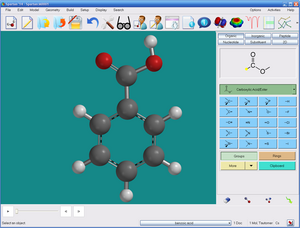Spartan (software)

Spartan graphical user interface
|
|
| Developer(s) | Wavefunction, Inc. & Q-Chem |
|---|---|
| Initial release | 1991 |
| Stable release |
Spartan'16 / 2016
|
| Development status | Active |
| Written in | C, C++, Fortran, Qt |
| Operating system | Windows, Mac OS X, Linux |
| Platform | x86, x86-64 |
| Available in | English |
| Type | Molecular modelling, computational chemistry |
| License | Proprietary commercial software |
| Website | www |
Spartan is a molecular modelling and computational chemistry application from Wavefunction. It contains code for molecular mechanics, semi-empirical methods, ab initio models,density functional models,post-Hartree–Fock models, and thermochemical recipes including G3(MP2) and T1.
Primary functions are to supply information about structures, relative stabilities and other properties of isolated molecules. Molecular mechanics calculations on complex molecules are common in the chemical community. Quantum chemical calculations, including Hartree–Fock method molecular orbital calculations, but especially calculations that include electronic correlation, are more time consuming in comparison.
Quantum chemical calculations are also called upon to furnish information about mechanisms and product distributions of chemical reactions, either directly by calculations on transition states, or based on Hammond's postulate, by modeling the steric and electronic demands of the reactants. Quantitative calculations, leading directly to information about the geometries of transition states, and about reaction mechanisms in general, are increasingly common, while qualitative models are still needed for systems that are too large to be subjected to more rigorous treatments. Quantum chemical calculations can supply information to complement existing experimental data or replace it altogether, for example, atomic charges for quantitative structure-activity relationship (QSAR) analyses, and intermolecular potentials for molecular mechanics and molecular dynamics calculations.
...
Wikipedia
